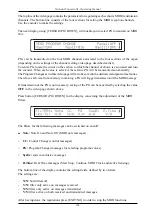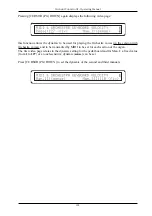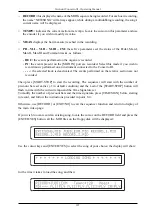
106
Viscount Concerto III - Operating Manual
8. RECORDING AND PLAYING BACK MUSICAL
PERFORMANCES
The Concerto III has a multitrack sequencer allowing the user to record, save on floppy disk and
play back musical performances. Besides this, the system allows MIDI sequences to be recorded in
multidubbing mode (i.e. in different steps) and the quantizing of MIDI events, and offers three
editing functions for modifying your recordings. The sequencer and the relative modification
functions are simple and user-friendly, ensuring that it is quick and easy to set up the instrument.
Each of the organ’s sections (Man.I, Man.II, Man.III and pedal) is recorded on a different track.
A fifth track records the stop status, Tutti, Crescendo, Couplers and manual settings. The names of
these tracks are as follows:
-
PD
(Pedal): the track used to record the note and volume events performed on the pedal board.
-
M.I
(Man.I): the track used to record the first manual events.
-
M.II
(Man.II): the track used to record the second manual events.
-
M.III
(Man.III): track for the third manual events.
-
CM
(Common): “common” track used for the stops, Orchestra voices (in the version of the
organ with Orchestra voices), couplers, Enclosed, Automatic Pedal and Keyboard Inversion.
It will be possible to record musical sequences up to a maximum of 60,000 MIDI events with a
resolution of 192 tpqn (ticks per quarter note).
The recordings are saved on floppy disks as MIDI (.mid) files in format 1. In this format, the
channels used to record the accompaniments are subdivided by tracks (unlike format 0, which
combines all the channels on a single track), keeping the organ’s sections subdivided for quicker,
easier interpretation.
This means that the songs recorded are compatible with even the most run-of-the-mill computer
MIDI software packages (for creating and printing out scores, modifying the song’s advanced
parameters, and so on).
8.1 RECORDING A PERFORMANCE
To start a recording session, simply press the [RECORD] button after inserting a floppy disk in the
drive. The system will proceed to read the disk and display:
after which it will show the video page used to set up the recording:
consisting of the fields described in next page.
















































